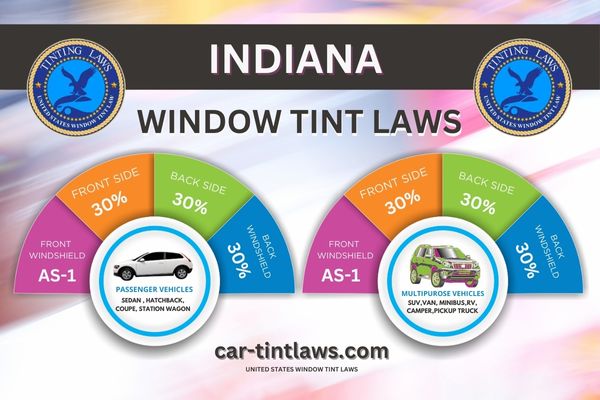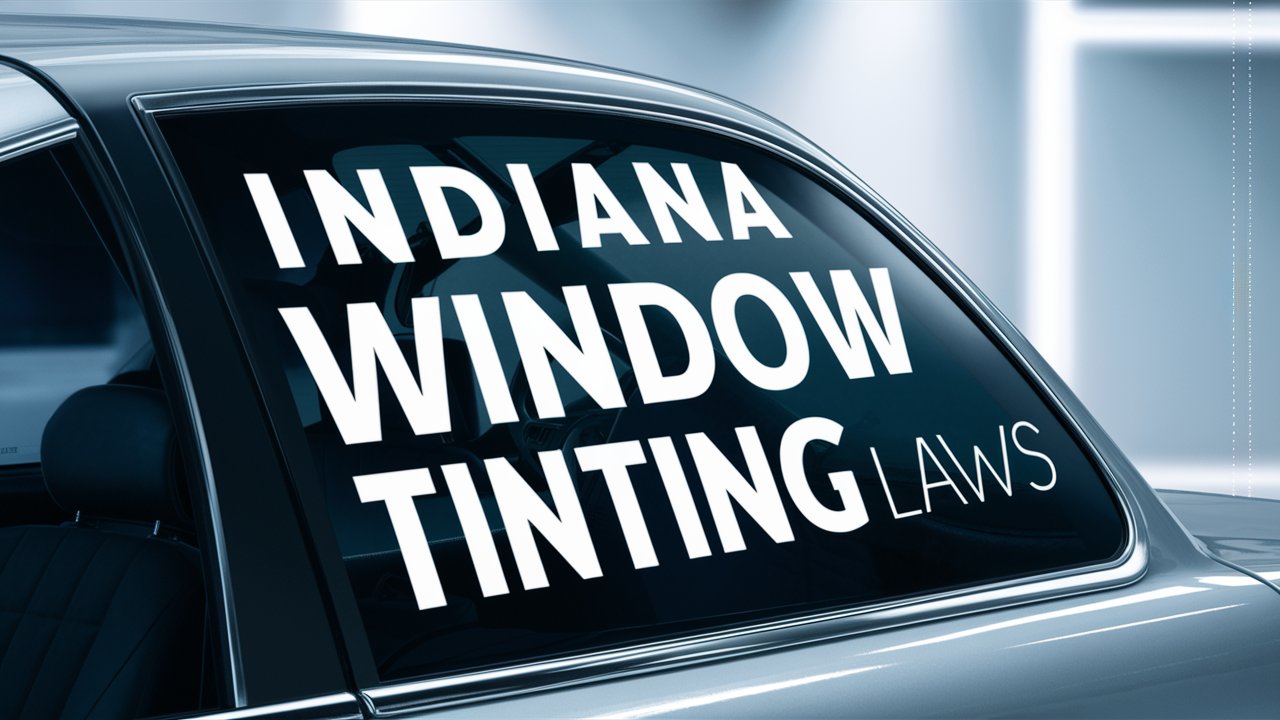It’s quite a coincidence that you’re considering window tinting in Indiana just as the laws are getting stricter.
If you’ve ever wondered how much light your car windows must allow through, it’s essential to know that sedans need to permit at least 30% on both front and rear side windows.
What about SUVs and vans? They have slightly different requirements, and there’s more to discuss regarding reflective tints and even medical exemptions.
Understanding these nuances can save you from hefty fines, so let’s explore what you need to know to stay compliant.
Window Tint Darkness in Indiana
When considering window tint darkness in Indiana, you’ll need to know the specific limits for different types of vehicles.
For both sedans and SUVs, the front side windows must allow at least 30% of light to pass through, and the same rule applies to the rear side and back windows.
Additionally, tint on the front windshield is only permitted above the AS-1 line.
Tint darkness for sedans:
- Windshield: Non-reflective tint is allowed on the top 6 inches of the windshield.
- Front Side windows: Must allow more than 70% of light in.
- Back Side windows: Must allow more than 70% of light in.
- Rear Window: Must allow more than 70% of light in.
Tint darkness for SUV and Vans:
- Windshield: Non-reflective tint is allowed on the top 6 inches of the windshield.
- Front Side windows: Must allow more than 32% of light in.
- Back Side windows: Any shade can be used.
- Rear window: Any shade can be used.
Indiana’s window tinting laws for SUVs and vans differ from those for sedans. SUVs and vans have more freedom when it comes to tint darkness on their back side and rear windows.
This means that you can choose any level of tint for these windows to suit your preferences, whether it’s for privacy, glare reduction, or aesthetic enhancements.
For SUVs and vans, the back side windows can be tinted to any extent, offering privacy for passengers or cargo.
Additionally, the rear window can also be tinted with any shade, making it ideal for those seeking privacy or sun protection for the vehicle’s interior.
This flexibility ensures that you can customize your vehicle’s tint to meet your specific needs while staying compliant with Indiana’s regulations.
It’s important to understand these variations in tint darkness regulations for different vehicle types in Indiana.
By knowing the specific allowances for SUVs and vans, you can make informed decisions about your window tint, ensuring that you stay within the legal limits while enjoying the benefits of personalized tinting.
Window Tint Reflection in Indiana
When it comes to window tint reflection in Indiana, you need to be aware of the specific regulations for different types of vehicles.
For sedans, any reflective tint is strictly prohibited, ensuring that drivers maintain clear visibility without distractions.
Similarly, SUVs and vans must also comply with this rule, as reflective tints can interfere with the safety of everyone on the road.
Tint reflection for sedans:
- Front Side windows: Reflective tint is not allowed on sedans in Indiana.
- Back Side windows: Reflective tint is not allowed on sedans in Indiana.
Tint reflection for SUV and vans:
- Front side windows: Prohibited to have reflective window tint.
- Back side windows and rear windows: No restrictions on tint darkness, as long as they are non-reflective.
Other Indiana window tint rules and regulations
- Side Mirrors: No restrictions.
- Restricted Colors: In Indiana, all tint colors are permitted.
- Certificates: Manufacturers of film need to certify the film they sell in the state. Ask your dealer if they are using certified film.
- Stickers: The sticker/label of compliance to identify legal tinting is required between the film & glass on each tinted window.
- Medical Exceptions: Indiana permits medical exemptions for special tint. For more details about the specific terms of the exemption, consult IN state law.
- Penalties: If caught violating Indiana’s window tint laws, the ticket costs can vary based on the severity of the infraction.

Medical Exemptions for Window Tint Rules in Indiana
For those with specific medical conditions, Indiana allows exceptions to the standard window tint laws to accommodate their health needs.
If you suffer from a medical condition like Albinism, Bloom Syndrome, or Cockayne Syndrome, you might qualify for a medical exemption waiver.
This waiver permits a lower tint percentage than typically allowed under Indiana window tint regulations.
Conditions involving extreme sensitivity to UV rays, such as Xeroderma Pigmentosum, also warrant such exemptions, enabling you to install darker window tints to protect your skin and eyes.
To secure a medical exemption, you’ll need to obtain a medical affidavit from your doctor.
This document must detail your medical condition and explain why lower VLT (Visible Light Transmission) window tint is necessary for your well-being.
Once you have the affidavit, follow Indiana’s state-specific rules to apply for the exemption.
It’s essential to make sure that your tint installation complies with the approved exemption to avoid legal issues.
Having a medical exemption guarantees that you remain compliant with Indiana window tint laws, even if your tint percentage exceeds the standard limits.
This accommodation supports your health needs while adhering to state regulations.
Indiana Window Tint Ticket Cost
Getting a ticket for illegal window tint in Indiana can cost you anywhere from $500 to $10,000, depending on the severity of the violation.
Indiana window tint laws categorize these violations as infractions, with the penalties ranging from a Class C infraction, carrying a maximum fine of $500, to a Class A infraction, which can reach up to $10,000.
The window tint ticket cost can escalate rapidly if you don’t address the issue promptly.
If you’re caught with illegal tint, you may be required to replace it with a legal film to avoid further penalties.
Repeat violations can lead to more severe fines and increased scrutiny from law enforcement.
Indiana’s laws are strict when it comes to ensuring compliance, and they mandate certification for any window tint sold in the state.
For those with medical conditions that necessitate darker window film, Indiana allows for medical exemptions.
However, you must have a valid waiver to legally use the darker tint.
Understanding these aspects of Indiana window tint laws can help you avoid costly illegal tint penalties and guarantee that you’re driving within the legal guidelines.
Indiana Climate and Tint Laws
Indiana’s climate, characterized by hot summers and cold winters, can greatly impact your decision on window tinting.
Proper tinting offers UV protection, which helps keep your car’s interior cooler and protects against sun damage.
Depending on the season, you might consider adjusting the level of tint to balance visibility and comfort.
Weather Impact on Tint
While Indiana’s climate features both scorching summers and frigid winters, it’s essential to understand how these extreme temperatures can impact your window tint.
The weather influence on window tinting is significant, as extreme temperatures can lead the tint to fade, bubble, or peel over time.
This not only affects visibility but also the overall appearance of your vehicle.
Indiana Tint laws require compliance, so maintaining your tint’s condition is vital.
Proper installation and high-quality materials are key to guaranteeing the durability of your window tint.
Opting for UV-resistant tint can help lessen the weather impact, as it is designed to withstand the harsh sun and cold conditions.
A reputable installer will make sure that the tint adheres correctly and performs well in Indiana’s variable climate.
Regular maintenance and inspections are also crucial to address any weather-related damage promptly and to stay within the legal requirements of Indiana’s tint laws.
UV Protection Benefits
Understanding how weather impacts your tint is important, but it’s equally vital to recognize the UV protection benefits that window tinting offers in Indiana’s climate.
Window tinting can block up to 99% of harmful UV rays, safeguarding your vehicle’s interior and reducing the risk of sun damage.
Given Indiana’s hot summers and intense sunlight, window tinting becomes a practical choice for maintaining vehicle comfort and protecting occupants.
Tinted windows effectively reduce interior heat by blocking the sun’s infrared light, ensuring a more comfortable driving experience, especially during the warmer months.
This reduction in interior heat directly influences energy consumption, as you’ll rely less on your vehicle’s air conditioning system, thereby saving fuel and reducing overall energy use.
Additionally, the UV protection benefits of window tinting can significantly enhance the resale value of your vehicle.
By preventing sun damage, the tint preserves the interior, which enhances the vehicle’s aesthetics and longevity.
Potential buyers often regard tinted windows as a valuable feature, making your vehicle more attractive in the market.
Seasonal Tint Adjustments
Adjusting your window tint seasonally can help you navigate Indiana’s diverse climate while staying within legal limits.
Indiana experiences four distinct seasons, which means you’ll face hot summers and cold winters.
Making window tint adjustments can optimize your vehicle’s comfort and visibility, ensuring a safer driving experience throughout the year.
During hot summers, darker window tint can greatly reduce interior heat and UV exposure.
This not only improves comfort but also protects your vehicle’s upholstery from fading or cracking.
By opting for a seasonal tint that’s darker in summer, you can keep your car cooler and more comfortable.
In contrast, Indiana’s cold winters might require lighter window tints. Lighter tints allow more natural light into your vehicle, enhancing visibility, especially in snowy or icy conditions.
This can be vital for driving safety, as better visibility helps you navigate winter roads more effectively.
References
Indiana Code Title 9, Article 19, Chapter 19: Windows and Windshield Wipers
Frequently Asked Questions
What Is the Darkest Legal Tint in Indiana?
You’re probably wondering about the darkest tint you can get in Indiana. It’s 30% VLT for front and rear side windows.
Tinting shops can help balance heat reduction and aesthetic appeal while ensuring visibility concerns and safety regulations are met.
Can You Get Pulled Over for Tint in Indiana?
Yes, you can get pulled over for tint in Indiana. Tint enforcement guarantees your tint modifications meet tint regulations.
If your tint visibility or tint safety is compromised, you might face tint fines. Stay compliant!
What Is the Legal Tint Limit in Indiana 2024?
You’re wondering about Indiana’s 2024 legal tint limits. For sedans, it’s 30% on all windows.
SUVs can have darker back windows. Regular tint inspections help avoid fines. Consider tint modifications, installations, and removals to stay compliant.
How to Get Tint Exemption in Indiana?
To get a tint exemption, you’ll need a medical affidavit for certain conditions. The exemption process involves presenting this documentation to law enforcement.
Confirm your tint percentages meet legal requirements and consult tint shops for compliance.
Conclusion
Understanding Indiana’s window tinting laws guarantees your vehicle complies with state regulations and avoids hefty fines, ranging from $500 to $10,000.
While these rules might seem restrictive, they balance personal vehicle customization with safety considerations.
Compliance involves using manufacturer-certified tint film, adhering to specific light transmission percentages, and ensuring no reflective tint on front side windows.
For those with medical conditions like Albinism, exemptions are available with proper documentation.
Following these guidelines helps maintain legal and safe tinting practices.
